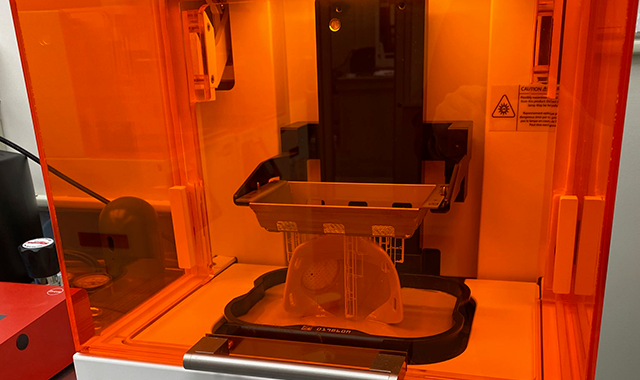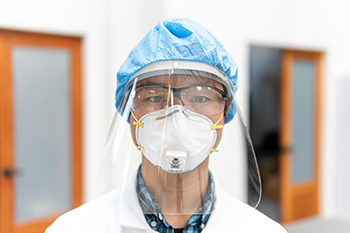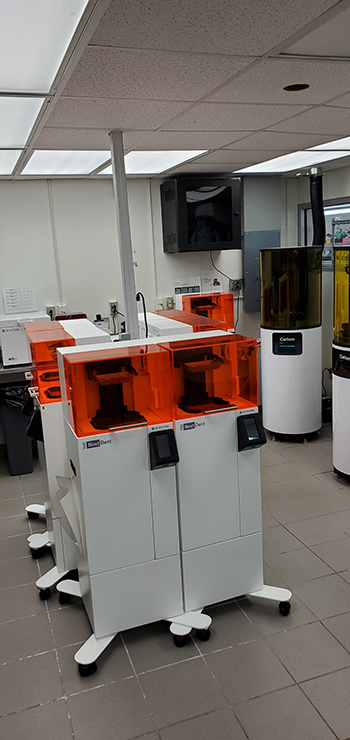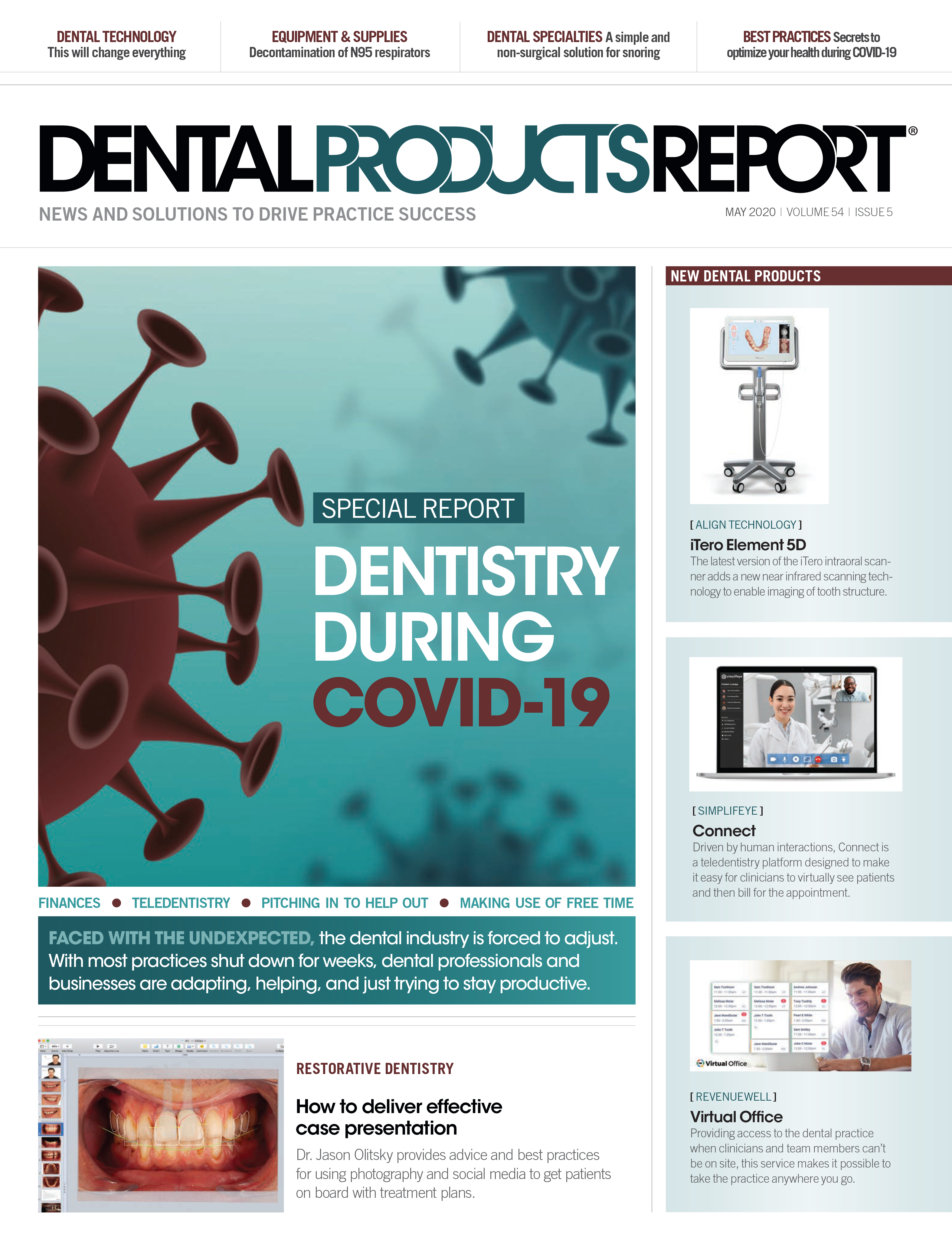Largely shut down, the dental industry steps up
In ways large and small, international and local, the dental industry is stepping up to help with the response to the COVID-19 pandemic.

Busy is the normal state of being for most dental practices, labs, and manufacturers because everyone is a potential patient, and oral health care is a constant need.
So, what happens when a global pandemic largely idles the industry? It certainly doesn’t sit still or stay on the sidelines. Dental professionals are in the business of helping, so during this pandemic, many dentists, hygienists, lab technicians, dental product manufacturers, and other dental professionals are finding ways to put their skills and equipment to use.
Dental practices have been shut down to all but emergencies in most states as a part of stay-at-home orders attempting to slow the spread of the coronavirus. This has left most practices with around 10 percent of usual revenues coming in and a lot of free time on their hands. The drop in practice production is felt similarly by dental labs and product manufacturers.
But as oral health care providers are shutting down, the hospitals managing patients with COVID-19 are facing supply shortages, especially when it comes to personal protective equipment (PPE) and supplies for administering COVID-19 tests. These are some of the gaps the dental industry is finding ways to fill.
Dental businesses are donating excess PPE supplies to local hospitals and other essential services, while those with the right equipment are now producing PPE and testing supplies, often using 3D printers. These efforts are being driven on local, and individual levels, but no one has been left to help alone. Shared information and digital resources are easily accessible for anyone who wants to help.
“We’re all in this together, and I think the strength of strategic alliances are very, very important in this time and it’s proved out to be a tremendous advantage,” says Brian Ganey, vice president of oral health at Carbon.
“It’s amazing to see how people are helping each other develop products, and how everyone is opening up and sharing ideas,” adds Maggie Dempsey, vice president of information systems & corporate development at Dental Arts Laboratories, Inc., of Peoria, Ill.
3D printing in the spotlight
A lot of this online sharing has been centered around 3D printers. Some of the larger 3D printer manufacturers are taking on lead roles to vet and distribute printable files for face mask headbands, testing swabs, a wide range of face mask designs, and more.
Face shield manufactured from medical grade material. The 3D print file is available to download from the 3D Systems website, or can be ordered from 3D Systems On Demand.

At 3D Systems, the company focused on keeping operations going in a safe manner. At the same time, they turned attention outward to interact with customers to assure them of ongoing support and to engage them in helping where they can, says Menno Ellis, senior vice president and general manager for Plastics at 3D Systems.
He sees his company’s technology as being absolutely critical during this pandemic because it can be implemented quickly, plans can be shared digitally, and the versatility of the technology can allow it to fill gaps when traditional supply chains break down. 3D printers are the perfect technology to keep hospitals focused on providing care instead of on finding supplies.
“3D printing allows you to address disruptions in a relatively fast manner,” he says. “This is a scenario where you can be the solution for that one broken weakest link in the chain, and by fixing that you can have a massive impact on what somebody else can do as part of their response effort.”
That impact is on full display right now, but it’s always been the potential of the technology, says Ben Johnson, director of healthcare product development at 3D Systems. Companies like his moved quickly to fill supply vacuums in the medical space, and the technology’s ability to support innovative approaches to product design and production creates new ways to integrate 3D printing into medical supply chains now and in the future.
“It’s been really amazing to see 3D printing can be used to rapidly iterate, develop, and provide the critical tools and products needed to respond to an unknown or unforeseen crisis like this,” Johnson says. “I think moving forward, 3D printing will be seen as a strategic resource to respond to unforeseen types of catastrophes.”
Disseminating designs
The story at Carbon has been similar. As the gravity of the pandemic set in, the company focused its efforts on helping increase COVID-19 testing capacity and helping meet the shortages in PPE face shields. The company found it was creating a lot of workable designs for these problem areas, and in order to engage with their customers, they made their design files for PPE face shields open source and available on their website so anyone with a printer could get started producing masks, says Carbon Chief Marketing Officer Dara Treseder.
Continue reading on next page…
Carbon has been engaging with customers via the company website, as well as via webinars. Smaller labs are printing materials and supplies for local distribution while larger customers, such as clear aligner maker Candid, have turned their printers to producing these supplies on a large scale.
“It’s been amazing to see our customers and partners really step up and start producing,” says Treseder.
A web page featuring sharable print files has also been a key part of how 3D Systems has coordinated with customers. The page includes print files along with detailed instructions on how to get the best results. The 3D Systems page also includes ways for people who have specific needs to solicit requests or people with printing capacity to find places that need the things they can produce, Ellis says.
During the COVID-19 pandemic the 3D printing room at Dental Arts Laboratories in Peoria, Ill. has been busy with systems from Carbon and 3D Systems producing masks and other supplies.

The 3D Systems page includes details about the company’s materials to help explain which materials can be used for which types of projects. Having materials with FDA clearance for intraoral use speeds up the process of safely designing components for medical uses. At 3D Systems, they’re working to leverage their materials data and processing data to create the most efficient and safest designs.
The ability to 3D print at scale is still a challenge for many, but when it exists, it can be a literal lifesaver. Treseder says an example of this is the partnership between Carbon and Resolution Medical. Both companies worked together, and Resolution is now printing more than a million of the new Resolution Medical Lattice Swab, Crafted with Carbon™ Technology each week. These conformal nasopharyngeal lattice swabs are in demand for COVID-19 screening tests and they are being printed using Keystone Industries’ KeySplint Soft Clear material which is most commonly used for printing dental splints.
Labs getting to work
At the individual dental lab level, the desire exists to jump into helpful projects, but while their efforts have been rewarding, labs are facing different challenges when working to help meet the shortages in supplies.
At Bismarck Mandan Dental Lab, a third-generation business in North Dakota, Ken Kincaid said his business is down to less than 10 percent of normal volumes, but they’re trying to stay open so they’re available to help doctors treating emergency patients. But as that is not enough work to fill the day, Kincaid jumped at designing and 3D printing face masks. After optimizating designs he found online, he began printing masks. However, Kincaid said he’s still trying to find out the best place for those masks, which are likely not approved for use in hospitals. Now they’re turning attention to other printing projects.
It’s been a similar story at Dental Arts Laboratories, Inc., where Dempsey says that while they remain fully operational and open for business, they too have experienced a sharp decline in cases coming in to the lab. With this extra time, they are also producing masks along with two different faceshields which they hope can be used in dental practices.
“Our idea is to provide something to our customers, our dentists, our practices, when they start opening their doors again,” Dempsey adds.
But making the masks has turned out to be the easier part of the process. Eric Kukucka, DD, president at The Denture Center in Canada, is also doing everything he can to stay busy while fewer cases come in. He’s focused on improving his business systems during the downtime, but he and his team also jumped at the opportunity to help and began working with online files to put their 3D printer to work producing face masks.
“It was extremely exciting, and it actually gave you a good feeling that maybe you could make a difference, or you could help make a change,” he says. “We got really excited at the opportunity, and we hit the ground running and threw ourselves into it 100 percent. Then you hit a roadblock and you look around and think, is this all for nothing?”
Caution, regulations, and scale
The hitch in the excitement at Kukucka’s lab is due to running up against the immovable obstacles of safety regulations, and other labs are experiencing this as well. While the masks look great, they have not been evaluated for effectiveness and many designs have not been approved for use by medical professionals.
“The biggest challenge is navigating the regulatory waters,” adds Dempsey.
That’s been the case for Kincaid as well. He said he’s slowed down producing masks after attending a National Association of Dental Laboratories webinar where the regulatory questions surrounding these printed masks was discussed. He plans to try to get clarification from the FDA about where and how these masks can be used prior to distributing them to health care workers.
Article concludes on page 3…
“For now, I’m going to get more information and still plan on producing masks and handing them out to family, friends, and then basically, if anybody wants one, they can call and say, ‘I would like one of these,’ and they’re going to have to understand this is not an FDA-approved product, but it’s also going to be better than a T-shirt,” Kincaid says.
A 3D printed respirator mask is produced at Dental Arts Laboratories.

Regulatory concerns are a part of the equation putting Kukucka on hold with mask production, but he’s also concerned about whether or not producing them at a small scale in his lab will make more of an impact than if they turn their printers toward producing less regulated devices such as face shield holders or mask holders.
“That’s where we’re stuck in the middle of all this, and it’s a really unfortunate,” he says.
While lots of questions remain, Ellis says he appreciates the way most dental labs are approaching these projects with pragmatism and an understanding and appreciation for safety standards, regulations, and best practices. Even if labs are not producing final pieces that will be used by someone in a hospital, by working to enhance and improve these crowd-sourced designs, those labs are helping with the overall effort to overcome the pandemic.
3D printing potential on display
So even as every good intention doesn’t lead to the desired outcomes and impacts, the collective efforts are not only creating parts and goods that help meet acute needs, they’re also validating, in real time, the true potential of 3D printing as a technology in the medical industries.
Because of the widespread nature of these efforts being taken on by people and businesses in different locations, local news coverage of these efforts has been widespread and, in some cases, people not familiar with the technology are learning about real world applications for 3D printing.
“3D printing, the promise of it, has always been for local production, and you’re starting to see that when supply chains are disrupted, 3D printing technologies are able to really step in and actually meet the production needs of their local areas,” Treseder notes. “I think one of the things that we’re going to continue to see, even after we as a society overcome COVID-19, is I think you’re going to continue to see just an interest and a desire to have digital manufacturing being mission critical. It’s been really amazing to see again, the power of the ecosystem, the power of the community, and how we’re able to step up.”
The dental industry might not be helping the same number of patients meet their oral health challenges as usual, but it’s definitely not sitting on the sidelines during the pandemic. Some efforts are making huge impacts, others are being felt just locally, and even some projects that looked promising have been abandoned, but in every instance the heart of the dental industry has been fully on display during this crisis.
“At the end of the day, it’s not for nothing: What we’ve witnessed in the last month is what a powerful force the dental industry is collectively, and how it’s coming together in innovations and ideas of these people integrating their knowledge,” Kukucka says. “People will remember what we did and what others have done during COVID-19 pandemic, and that’s what’s going to determine who you are-in terms of social responsibility-for years to come.”

Product Bites – January 19, 2024
January 19th 2024Product Bites makes sure you don't miss the next innovation for your practice. This week's Product Bites podcast features new launches from Adravision, Formlabs, Owandy Radiology, Henry Schein Orthodontics, Dental Creations, and Dental Blue Box. [5 Minutes]
3D Systems Garners FDA Clearance for Multi-material, Monolithic Jetted Denture Solution
September 17th 2024The company’s unique multi-material, single-piece dentures are designed to offer a combination of distinctive break resistance and outstanding esthetics for enhanced patient experience, and Glidewell labs are currently implementing the solution.